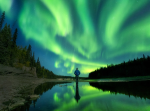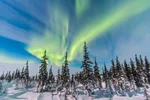Northern lights tours in Whitehorse, Yukon
Experience the enchanting dance of the Northern Lights in the Yukon territory of Canada. The Northern Lights, also known as the aurora borealis, are a breathtaking celestial phenomenon where vibrant colours dance across the night sky. This natural wonder occurs when charged particles from the sun collide with atoms in the Earth's atmosphere, producing an ethereal spectacle that is both awe-inspiring and mystical.
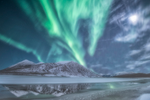
Table of contents
- Popular Northern Lights Yukon tours
- Yukon: A top Northern Lights destination
- Best Time to See Northern Lights in the Yukon
- Best Places in Yukon to see Northern Lights
- Accommodation options
- Transportation in the Yukon
- Other activities during a trip to see the Northern Lights
- The Midnight Sun experience
- Cultural significance of the Northern Lights
- Northern Lights etiquette and responsible tourism
- Aurora forecasting in Yukon
- Tips for enjoying a night of viewing the Aurora Borealis
- Quick facts about the Northern Lights in the Yukon:
- Frequently asked questions
Nestled in the untamed wilderness of Canada's far north, the Yukon is a premier destination for viewing the Northern Lights. Situated at a high latitude, the Yukon is within the Aurora Oval, an area known for frequent and intense auroral activity. The Yukon's winter months provide extended periods of darkness. From late August to mid-April, longer nights offer a greater chance of seeing the Northern Lights.
Beyond the auroras, the Yukon also offers a myriad of other attractions that make it a must-visit destination. From dog sledding through snowy landscapes to soaking in natural hot springs, the Yukon promises an unforgettable adventure. Discover the magic of a Northern Lights Tour Yukon and let the aurora borealis weave its spell on your senses, creating memories that will last a lifetime.
The travel experts at northernlightscanada.com can help you plan an unforgettable Northern Lights trip to Whitehorse, Yukon. As part of our personalized travel support from planning through travel, we take care of all the arrangements in the area. We book your aurora-viewing tours, accommodations, and unique local experiences. You get to relax and enjoy making memories.
Popular Northern Lights Yukon tours
Northern Lights of the Yukon
Fly from Vancouver to Whitehorse, the capital of the Yukon territory and one of the best places to see the Northern Lights in Canada. Each evening of your four-night stay in Whitehorse, you’ll venture out of the city in search of the Northern Lights. During the day, explore the winter landscape on guided excursions, including a Whitehorse city tour, wildlife preserve tour, and a dog sledding experience.
Trip length (number of nights): 5
Nights in the Yukon: 4
Aurora viewing evenings: 4
** A version of this Yukon Northern Lights tour is available during the fall months. Please contact one of our Vacation Advisors if you’d prefer to travel between August and October. The fall itinerary includes dog carting instead of dog sledding.
Yukon Northern Lights Resort and Spa in Winter
The Northern Lights Resorts and Spa is a fantastic place for Northern Lights viewing in Whitehorse. Located 20 minutes away from downtown, the property is surrounded by beautiful pine forests and mountains and is close to the Yukon River. Spend four nights viewing the Northern Lights and discovering the highlights of Whitehorse. Enjoy a range of outdoor winter activities, guided tours, delicious meals, and treat yourself to a spa service.
Trip length (number of nights): 5
Nights in the Yukon: 4
Aurora viewing evenings: 4
** A version of this tour is available during the fall months. Please contact one of our Vacation Advisors if you’d prefer to travel between August and October. The fall itinerary includes a Southern Lakes tour, where you can visit Emerald Lake, Carcross Desert, and the village of Carcross.

Keep reading or chat with one of our local travel experts. We’re passionate about Canada and can help you at any stage of your vacation planning.
Yukon: A top Northern Lights destination

Situated in Canada's far north, the Yukon lies within the region known as the Aurora Oval. This oval-shaped area around the polar region has frequent and intense auroral activity. This unique location, combined with the territory's low light pollution and vast open spaces, creates an ideal setting for experiencing clearer and more vibrant displays of the aurora.
One of the key factors that make the Yukon a prime destination (1) for viewing the Northern Lights is its minimal light pollution. The territory's vast open spaces and sparse population contribute to remarkably dark skies. This lack of light pollution allows the aurora to shine through with clarity and enhances the visual impact of the lights.
The vast open spaces of the Yukon add another layer of magnificence to the Northern Lights experience. Imagine being surrounded by nothing but untouched wilderness, far away from city lights and distractions. In this pristine setting, the aurora becomes the focal point, captivating your senses and drawing you into its ethereal dance.
Best Time to See Northern Lights in the Yukon
Clear, dark skies are of utmost importance when it comes to viewing the Northern Lights. When the skies are clear and free from clouds, the vibrant colors of the aurora can be seen vividly against the backdrop of the night sky.
The weather conditions in the Yukon can vary, and it's essential to plan accordingly. Cloud cover can obstruct the view of the Northern Lights, so keeping an eye on weather forecasts is helpful. Although it's impossible to predict with absolute certainty, nights with clear or partially cloudy skies are more likely to have a remarkable display of the aurora. Local tourism centers, tour guides, and accommodations in the Yukon can provide valuable information and updates on weather conditions to help optimize your Northern Lights experience.
In terms of climate, the Yukon's winter is cold. Between November and March, the temperature is between -40 and -13 degrees Celsius. It's important to dress warmly during your Northern Lights trip. Proper winter gear, including insulated jackets, hats, gloves, and warm footwear, is essential for enjoying the experience to the fullest. Many accommodations in the Yukon offer cozy lodging options with fireplaces and hot drinks to keep you warm. Northern Lights viewing areas often have an outdoor fire and a place of shelter, like a heated wall tent.
To fully immerse yourself in the beauty of the Northern Lights and explore the other wonders of the Yukon, it is recommended to plan a stay of at least three to five days. This duration allows for flexibility in terms of weather conditions and increases the chances of witnessing the Northern Lights. It also provides an opportunity to engage in other winter activities, such as dog sledding, snowshoeing, or ice fishing.
Why book your trip with Fresh Tracks Canada?
Unforgettable Canadian vacations made just for you
Enjoy local expertise and guidance with a fully planned itinerary. Personalize your trip by adding extra time in Canada at the start or end of your Northern Lights tour.
We take care of all the details
Relax and focus on making memories. Let us make all of the bookings for you, including your guided Northern Lights tour, hotels, excursions and activities, and transfers.
Support when you need it
We’re here to make sure you get the inside scoop before you even leave home. And you can relax on your vacation because you know that we’re a phone call away if you have any questions while you’re in Canada.
Best Places in Yukon to see Northern Lights
Wondering where to see Northern Light in Yukon? There are two main locations for witnessing the Northern Lights in Yukon. Each destination provides a unique experience along with a variety of amenities to ensure a comfortable and memorable stay.
1. Whitehorse
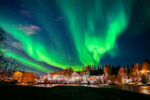
As the capital of the Yukon, Whitehorse offers a convenient base for experiencing the Northern Lights. There are regular flights in and out of the city, so Whitehorse is often the first stop on any Yukon itinerary. The city provides a range of accommodation options, catering to various budgets and preferences. There is an array of restaurants, cafes, and bars serving local and international cuisine, ensuring a delightful culinary experience.
2. Dawson City
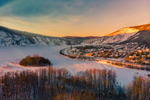
Dawson City, known for its rich Klondike Gold Rush history, also serves as an excellent location for Northern Lights viewing. This charming town offers a unique blend of heritage and adventure. Accommodation options include historic hotels, cozy cabins, and charming guesthouses, immersing you in the town's rich cultural ambiance. Local eateries, pubs, and restaurants provide a range of dining options, allowing you to savor local flavors while recounting the tales of the Gold Rush era.
Accommodation options
When it comes to viewing the Northern Lights in the Yukon, choosing the right accommodation can greatly enhance your experience. From downtown hotels to lakeside cottages and remote lodges, each option has unique features and benefits.
1. Downtown hotels
Downtown hotels in cities like Whitehorse offer convenience and easy access to amenities. They provide a range of facilities, including comfortable rooms, on-site dining, and proximity to local attractions and tour operators. If you prefer the comforts of urban life while having the Northern Lights within reach, downtown hotels are a suitable choice. You can stay in downtown and then head to remote locations on the nights you want to view the Northern Lights. Hotels include the Best Western Gold Rush Inn and Raven Inn.
The proximity to urban areas may result in light pollution, which can diminish the visibility of the Northern Lights. While you can still catch glimpses of the lights near downtown, they appear more vibrant further away from the city.

2. Lakeside accommodation
There are some accommodation options near lakes in the Yukon. They provide a serene and picturesque setting, allowing you to immerse yourself in the beauty of nature. These accommodations often offer cozy interiors, stunning views, and a peaceful atmosphere. Being away from urban areas, you can enjoy darker skies and a higher chance of witnessing vibrant displays of the Northern Lights. The Inn on the Lake is a popular choice for this type of accommodation.
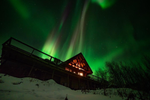
3. Remote lodges
Remote lodges offer an immersive experience in the heart of nature. These accommodations, often nestled in pristine landscapes, provide an excellent opportunity to escape light pollution and fully embrace the Northern Lights. These packages include guided tours, outdoor activities, and knowledgeable staff who can enhance your aurora viewing experience.
Remote lodges, like Northern Lights Resort and Spa, are typically located further away from urban areas. Keep in mind that transportation arrangements may be required for additional excursions or to reach nearby towns for additional services.
No matter which accommodation option you choose, the Yukon's vast landscapes and its dedication to preserving natural wonders ensures an unforgettable Northern Lights experience. Chat to one of our Vacation Advisors, who can help you select the option that best aligns with your preferences.
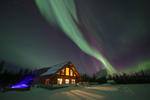
Transportation in the Yukon
Yukon offers several transportation options for travelers to navigate the vast landscapes and reach locations for viewing the Northern Lights.
In our multi-day Yukon Aurora tours, some transportation, like airport to hotel transfers, is included. For example, on our Northern Lights of the Yukon trip, you’ll get picked up from the Whitehorse airport and be taken to a downtown hotel. Then, each night, enjoy guided northern lights viewing. Knowledgeable guides will take you to optimal viewing spots, share insight about the Northern Lights, and provide photography tips. This is a convenient option for those unfamiliar with the region and seeking a hassle-free experience.
While it is possible to rent a car and explore the Yukon at your own pace, some travellers find it difficult to navigate the winter road and weather conditions. There is a taxi company in Whitehorse, which is useful if you want to get to restaurants or do additional sightseeing on your own.
Other activities during a trip to see the Northern Lights
In addition to witnessing the breathtaking Northern Lights in the Yukon, add variety to your trip by participating in exciting day tours and engaging in a range of outdoor activities. During daylight hours, immerse yourself in the pristine winter landscapes and embark on unforgettable adventures. Here are some captivating activities to consider:
1. Dogsledding
Glide through snowy landscapes while being pulled by a team of energetic and friendly sled dogs. Dogsledding allows you to appreciate the harmony between humans, animals, and nature while reveling in the tranquility of the winter wilderness.

2. Ice fishing
Embrace the traditional Canadian winter pastime of ice fishing. Venture onto frozen lakes and drill a hole through the thick ice to drop your line and wait for a fish to bite. Ice fishing provides a unique opportunity to connect with nature, appreciate the serenity of the frozen surroundings, and potentially catch lake trout or Arctic grayling.
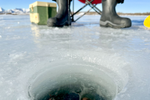
3. Snowmobiling
Feel the exhilaration as you zip through snow-covered trails on a snowmobile. This high-speed adventure allows you to explore the vast Yukon landscapes with ease, reaching remote areas that would otherwise be inaccessible. Enjoy the adrenaline rush and panoramic views as you navigate through winter wonderlands, experiencing the raw beauty of the region.
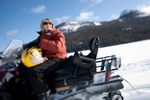
4. Snowshoeing
Strap on a pair of snowshoes and traverse through snow-covered forests along pristine trails, immersing yourself in the tranquility of the winter landscape. Snowshoeing offers a slower pace, allowing you to appreciate the intricate details of nature while getting a great workout.

The Midnight Sun experience

While the Northern Lights captivate the night sky, the Midnight Sun is a completely different natural phenomenon. In the summer months, particularly around the summer solstice, the Midnight Sun occurs in the high latitudes, including the Yukon. During this period, the sun remains visible even at midnight. The bright and continuous daylight provides opportunities for outdoor adventures, such as hiking, canoeing, and enjoying extended hours of exploration under the sun. If you visit the Yukon during the summer, you will not be able to see the Northern Lights because of the Midnight Sun.
The difference between the Midnight Sun and the Northern Lights lies in their occurrence and appearance. The Midnight Sun is a result of the Earth's axial tilt, causing the sun to remain above the horizon for extended periods during summer. In contrast, the Northern Lights, or Aurora Borealis, is a phenomenon that occurs year-round but is most visible during the dark winter months. The Northern Lights are a mesmerizing display of colorful lights dancing across the night sky, caused by solar particles interacting with the Earth's atmosphere.
Cultural significance of the Northern Lights

The Northern Lights hold deep cultural significance in the Indigenous communities of the Yukon.
For Indigenous peoples, the Northern Lights are not merely a scientific phenomenon; they are seen as celestial spirits dancing in the sky, telling stories and communicating with the Earth. The lights are often considered a connection between the physical and spiritual realms, carrying messages from ancestors, and serving as a reminder of the interconnectedness of all living beings.
On your Northern Lights journey, you might have the opportunity to engage with local Indigenous tourism operators, cultural centers, and communities. They offer opportunities to learn and listen. Through this interaction, you can cultivate a deeper understanding of the Northern Lights' cultural significance and learn about the rich Indigenous heritage of the Yukon.
Northern Lights etiquette and responsible tourism
When embarking on a journey to witness the captivating Northern Lights in the Yukon, it is essential to practice responsible tourism. Respecting the environment, wildlife, and local communities is crucial to preserve the beauty of the natural surroundings for future generations. Here are some key principles to keep in mind:
1. Minimize your impact
Leave no trace as you explore the Northern Lights viewing areas. Follow the principle of "pack it in, pack it out" by carrying out any trash or waste you generate. Respect nature's delicate balance by refraining from littering, damaging vegetation, or disturbing wildlife habitats. Remember, you are a guest in the pristine wilderness of the Yukon, and it is essential to treat the environment with care and consideration.
2. Follow local guidelines
Familiarize yourself with any guidelines or regulations set forth by local authorities or tour operators. These guidelines are in place to ensure the safety of visitors and the protection of the environment. Be mindful of any restricted areas, designated viewing spots, or specific instructions provided by guides.
3. Respect local communities
Engage with local communities respectfully and learn about their culture and traditions. Seek opportunities to support local businesses and artisans, promoting economic sustainability. When interacting with Indigenous communities, always follow cultural protocols and seek permission before taking photographs or participating in cultural activities.
4. Educate yourself
Before your trip, take the time to learn about the Yukon's ecosystems, wildlife, and cultural heritage. Understanding the local environment and its significance will deepen your appreciation for the Northern Lights and the region. Educate yourself on the Northern Lights phenomenon, Indigenous perspectives, and any specific ecological considerations that may apply.
Let your journey to witness the Northern Lights in the Yukon be not just a personal adventure, but also a sustainable and respectful experience. Embrace responsible travel practices, respect the environment and local communities, and create lasting memories while leaving a positive impact on this remarkable destination.
Aurora forecasting in Yukon
There are several aurora forecasting tools and resources available to help you predict and plan your viewing experience. These online platforms and smartphone apps provide real-time information about solar activity and aurora predictions.
1. Space Weather Prediction Center (SWPC)
Operated by the National Oceanic and Atmospheric Administration (NOAA), the SWPC (2) offers valuable data and forecasts related to space weather, including the Northern Lights. Their website provides a range of information, such as the Kp index (a measurement of geomagnetic activity), solar wind data, and geomagnetic storm predictions. Monitoring the SWPC's updates can give you insights into the likelihood and intensity of the Northern Lights.
2. University of Alaska Fairbanks Geophysical Institute
The Geophysical Institute at the University of Alaska Fairbanks maintains an informative website that includes aurora forecasts and real-time data. Their Aurora Forecast page provides a 30-minute forecast for the Northern Lights' visibility, based on factors like solar wind speed and density. The site also features an interactive map showing the probability of viewing the lights in different areas of the Yukon.
3. Aurora Alerts North
Aurora Alerts North is a smartphone app designed specifically for predicting the Northern Lights in the Yukon and other northern regions. The app utilizes real-time solar wind data and algorithms to provide users with alerts and forecasts for potential aurora sightings. It offers customizable notifications based on your preferred viewing location, ensuring you never miss an opportunity to witness the lights.
4. Social media
Platforms like Facebook, Twitter, and Instagram have communities where individuals share their experiences, photos, and current sightings of the aurora.
It’s important to remember that aurora forecasts are not foolproof, as the lights are a natural phenomenon influenced by various factors. However, utilizing these tools can provide valuable insights into solar activity and geomagnetic conditions.
Even without precise predictions, simply being in a prime viewing location with clear skies and minimal light pollution can offer unexpected, awe-inspiring Northern Lights displays.
So, use these aurora forecasting tools and resources to prepare for your trip, but don't forget to embrace the enchantment of the unknown. Allow the Northern Lights to surprise and delight you as they paint the Yukon's sky.
Tips for enjoying a night of viewing the Aurora Borealis
To ensure an unforgettable experience while viewing the Aurora Borealis in the Yukon, it's important to be prepared for cold nights. Here are some valuable tips to make the most of your Northern Lights adventure:
1. Dress warmly
It's essential to bundle up in layers, especially if you visit the Yukon in winter. Dress in thermal or woolen base layers, followed by an insulated jacket or parka. Wear a hat, gloves, scarf, and thermal socks to keep extremities warm. Thermal boots with good traction are also recommended. Some of our Northern Lights vacation packages include winter clothing rentals so you can save space in your luggage!
2. Use the comfortable seating provided
Northern Lights viewing sites provide benches or other seating options. On guided tours, you are taken to sites where seating is provided so you don’t have to stand for long periods of time. Be patient and stay prepared, as the lights can appear and disappear throughout the night. Do use the seating as you could be there for many hours.
3. Check the conditions
Before heading out, monitor weather forecasts and aurora activity updates. Clear skies are ideal for optimal Northern Lights viewing, so a night with minimal cloud cover is best. Utilize aurora forecasting tools and resources to gauge the likelihood of a vibrant display. While you’ll book your Northern Lights trip months in advance, checking the weather and aurora forecasts will help you prepare for the conditions, get excited, and manage expectations.
4. Bring photography gear
If you're interested in capturing the magic of the Northern Lights through photography, consider bringing a tripod to keep your camera steady during long exposures. Wide-angle lenses with a low aperture (e.g., f/2.8 or lower) are recommended. Familiarize yourself with your camera's manual settings for long exposures and experiment with different shutter speeds and ISO settings to achieve the desired results. Generally, you’ll want a low shutter speed and a high ISO value, though it does depend on how quickly the lights are moving and how bright they are.
Quick facts about the Northern Lights in the Yukon:
- The intensity and colors of the Northern Lights vary depending on the solar activity and atmospheric conditions.
- The lights often appear green but can also display shades of pink, purple, yellow, and even red.
- The Yukon's long winter nights, from November to April, provide extended periods of darkness for Northern Lights viewing.
- The Northern Lights can be seen in the Yukon during the fall, from August to October.
What Our Customers Say
We got to see the Northern Lights
Our vacation was unbelievable! We got to see the Northern Lights and my kids loved the dog sledding. We wish we would have stayed longer.
![Helen, Pedro, Kevin and Denise review of their [object Object] trip](https://cdn.bfldr.com/UAHFH8T4/as/4xh5n4jjpwwb479msx7h83v/Helen_Pedro_Kevin_Denise_388?auto=webp&format=webp&width=75)
Helen, Pedro, Kevin and Denise
NSW, AUSTRALIA
A fantastic bucket list trip
We had a fantastic bucket list trip! Everything worked out well – the accommodations were perfect, people were lovely, food was delicious, guides were all very knowledgeable, and e...

Liz and Adolf
MA, USA
Frequently asked questions
Where to stay in Yukon to see Northern Lights?
To see the Northern Lights in the Yukon, stay in areas with minimal light pollution, such as Whitehorse, Dawson City, or remote lodges.
Is Yellowknife or Whitehorse better for Northern Lights?
Both Yellowknife (Northwest Territories) and Whitehorse (Yukon) offer excellent opportunities to witness the Northern Lights. Whitehorse has a range of accommodation, restaurants, and activities. While in Whitehorse, you can visit Eclipse Nordic Hot Springs and the Yukon Wildlife Preserve.
How long does the Northern Lights season last in Yukon?
The Northern Lights season in Yukon typically lasts from October to April, with the darkest months of December and January offering the highest chances of visibility. The best time of year to see Northern Lights in Yukon is during fall or winter.
What is the best month for Northern Lights in Yukon?
The winter months are the best for Northern Lights viewing in the Yukon.
What is the likelihood of seeing the Northern Lights in Yukon?
The likelihood of seeing the Northern Lights in Yukon is high, with clear skies and minimal light pollution contributing to optimal viewing conditions.
What is the average duration of a Northern Lights display in Yukon?
The average duration of a Northern Lights display in Yukon can vary greatly, ranging from a few minutes to several hours. Patience is key, as the lights can ebb and flow throughout the night.
Are there any safety considerations or precautions to take while viewing the Northern Lights in Yukon?
While viewing the Northern Lights in Yukon, it's important to dress warmly, bring necessary supplies, and be cautious of potential hazards in the dark and cold environment. Stay aware of your surroundings and follow safety guidelines provided by tour guides or local authorities.
Are there any local festivals or events celebrating the Northern Lights in Yukon?
Yukon hosts the annual "Yukon Sourdough Rendezvous" festival, which celebrates winter in the Yukon. View the Northern Lights and enjoy other cultural events, such as dog sledding races, snow carving competitions, and live music performances.
What is Yukon known for?
Yukon is famous for its stunning wilderness, vast landscapes, gold rush history, pristine national parks, and, of course, the captivating Northern Lights that adorn its night sky.
What food is Yukon known for?
Culinary dishes in the Yukon often feature regional ingredients like bison, Arctic char, salmon, and potatoes.
Explore more tours
Discuss your Northern Lights tour with a Canadian travel expert
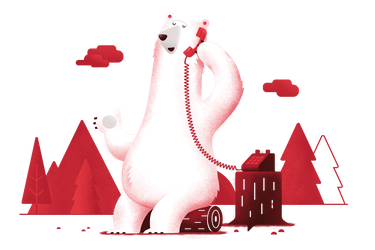

Sign up for travel inspiration
Our newsletter is full of travel tips and local insights for your Northern Lights tour in Canada.
